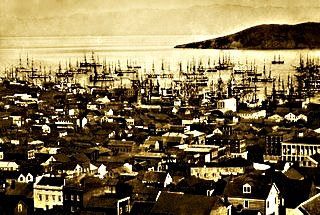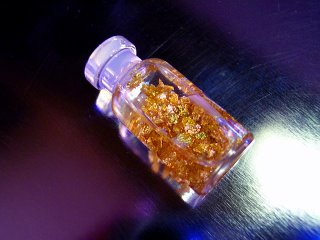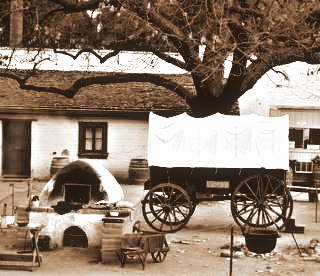Discover the Adventure:
Going to California for Gold
After the Discovery of Gold
Going to California's Gold Fields Wasn't Easy in 1849!
In 1848 and '49, as word spread that gold had been found in amazing quantities in California, there were only two ways an adventurous Argonaut-wannabe could travel to California: by sea-going vessel around The Horn or overland - usually by covered wagon.
Both routes were long and arduous, often fraught with dangers and delay.
And, as if just getting to California wasn't hard enough - once they arrived, they still had a long way to go before reaching the actual goldfields.
The ocean travelers who arrived in San Francisco first, still had to cross the Coastal Mountains, traverse the vastness of the Great Central Valley, and make their way up into the foothills of the Sierra Nevadas.
Those who traveled overland usually stopped first at Sutter's Fort to rejuvenate and restock their supplies before heading across the Central Valley and up into the foothills.
Do you have a Gold Country story?
If you're exploring California's Gold Country, you'll likely need
a place to stay. Compare prices and amenities at HotelsCombined.com before you book:

After the Discovery of Gold
Going to California in 1848 and 1849
|
|
 San Francisco Harbor 1851; Photographer Unknown San Francisco Harbor 1851; Photographer Unknown
Whether they were headed to the Northern mines like Coloma, Auburn, and Georgetown; or the Southern mines like Jackson, Mokelumne Hill, and San Andreas, it was about 140 miles from San Francisco to the goldfields. |
Both routes required getting through the Coastal Mountain Range and crossing the Great Central Valley to reach the foothills of the Sierra Nevada Mountain range.
There were supplies to be acquired and arrangements to be made for transportation. The competition was fierce!
Those traveling to Coloma, where gold was first discovered, and the Northern mines sailed up the Sacramento River to what's known as Old Sacramento today.
Those heading for the Southern mines sailed along the San Joaquin River to Stockton before heading South. Either way, they would continue across the Central Valley on foot, on horse- or mule-back, or aboard a wagon and up into the foothills.
In the meantime, one result of all these ships arriving in San Francisco Bay had a profound impact on the newly burgeoning city of San Francisco.
So many ship's crews caught the gold fever along the way and deserted their ships for the get-rich-quick promise of going to California's goldfields that the captains couldn't return to their home ports.
Instead they sold their sails for tents, rented out their ships for warehouses, shops, and hotels, or sold the ship for its lumber and/or to be used as landfill.
That's right - landfill! Much of what is now the City of San Francisco
is built atop what used to be the harbor!
Looking for a Gold Country hotel? Compare prices before you book at HotelsCombined.com:

Upon the Discovery of Gold
Covered Wagons Going to California Arrived at Sutter's Fort
When travelers arrived at Sutter's Fort from the ships in San Francisco Bay, they most likely met up with those who had come overland in covered wagons, as John Sutter was known to be encouraging and helpful to California-bound immigrants.
Of course, Sutter had his own ulterior motives for being helpful. He wanted settlers who would stay in the area, use his products and services, and thus help him to grow his empire.
Once gold was discovered however, these settlers joined the rest of the 49ers in abandoning all civilized activities in favor of getting rich quick (or so they hoped)!
But they had a long ways to go to reach the goldfields too! It was about 50 miles just to reach Coloma, the goldfield closest to Sacramento. Beyond that - and progressively farther away - were Auburn, Grass Valley, and Nevada City to the North, or Placerville, Plymouth, Amador City, Jackson, etc. to the South.
Going to California to Find Gold
was the Goal of Tens of Thousands of People
 Vial of Gold; © Jane A. Sawyer
Vial of Gold; © Jane A. SawyerBut whether they traveled by sea or by land; along the Sacramento River or the San Joaquin; they were a determined lot, and came they did!
They were the adventurers and they were taking part in what was to become one of the greatest human migrations in recorded history.
From 1848 to 1850, California's population increased from 14,000 to 100,000, growing to 200,000 by 1852, and exceeding 300,000 in 1853.
These 49ers also ultimately provided the impetus for the creation of
a
Transcontinental Railroad which would bind the Eastern and Western
seaboards of the United States and greatly hasten the settlement of the
vast territories in between.
No longer would it take four to six months to get to California - the California Gold Rush had changed the world forever!
If you're interested in how the 49ers got to California:
- Around the Horn
One way of going to California and the goldfields was to traverse the Horn by sailing ship, which often took almost as long as the overland route. - Overland by Covered Wagon
The other way of going to California and the goldfields was to spend up to six months walking alongside a prairie schooner.
For what they did once they arrived, take a look at these pages:
- San Francisco during the Gold Rush
Follow the self-guided walking tours called The Barbary Coast Trail and The Gold Rush Trail. - Follow the Sacramento River from San Francisco to Sacramento
Want to know which route the 49ers took from San Francisco to Sacramento City? - Old Sacramento
What did the 49ers find when they reached Sacramento City? - Sutter's Fort
Sutter's Fort - a step back in time!
Please continue your exploration of what Northern California has to offer by using the Nav Bars in the left and right columns or by using the links at the bottom of the page.
Like what you're finding here at Discovering Northern California? Then please share with the Social Network of your choice.
And thanks for coming!
Return to Discover Northern California's Home Page from
Going to California
Related Pages
California Gold Rush
California Gold Rush
Discovery of Gold
Getting to California
Gold Rush Trail
Gold Rush Sites
Gold Panning
Related Pages
More CA History
1906 Earthquake
California Gold Rush
CA Gold Rush Sites
California Missions
Sonoma Plaza History
Sutter's Fort
Related Pages
Hints & Tips
Beach Safety Tips
Best Kept Travel Secrets
Family Camping Tips
iPhone Travel Apps
Nude Beaches
Tide Pool Tips
Travel Sites We Love
Travel Tips
Whale Watching Tips
Wine Tasting Tips
Winter Driving Tips
Related Pages
Things To Do
Activity Village
Attractions
Beaches
Beer Lovers Delight
Burney Falls
Camping
Casa de Fruta
Day Trips
Gold Panning
Gold Rush Sites
Healdsburg
Historic Grass Valley
Lake Shasta Caverns
Lodi
Missions
Nevada City
RV Destinations
Ski Resorts
Tide Pool Tips
Travel Tips
Weekend Trips
Whale Watching
Wine Tasting
Related Pages
Free Things To Do
Free in Big Sur
Free in Chico
Free in San Francisco
Free in Sonoma
Related Pages
Insider Secrets
Best Kept Travel Secrets
Best Winter Whitewater
Boring Road? Nope
CA Admission Day
Climbing at Castle Rock
Crabbing Spots
Dream of Dreams
Fall in Eastern Sierras
Ghost Stories
Glass Beach
Great Stays, Low Pays
How to be a Valley Girl
Jade Beach
Lake Shasta Caverns
Lassen Volcanic SP
Lost Coast
Mono Lake
Moss Landing: Whales
New Clairvaux Abbey
Panning for Gold
Pygmy Forest
Mendo to Eureka
RV Destinations
SF Great Places to Eat
SF: More About Eating
SF Neighborhoods
SF Giants Baseball
Santa Cruz: Memories
Santa Cruz: Old Friends
Sonoma Cooking Class
Sonoma History
Sonoma Top Wine Stop
Tahoe: Discovery Trail
Underground Gardens
Yosemite: Family Hikes
Yosemite: High Country
YNP: Off the Beaten Path
Yosemite: Taft Point
Ziplines
